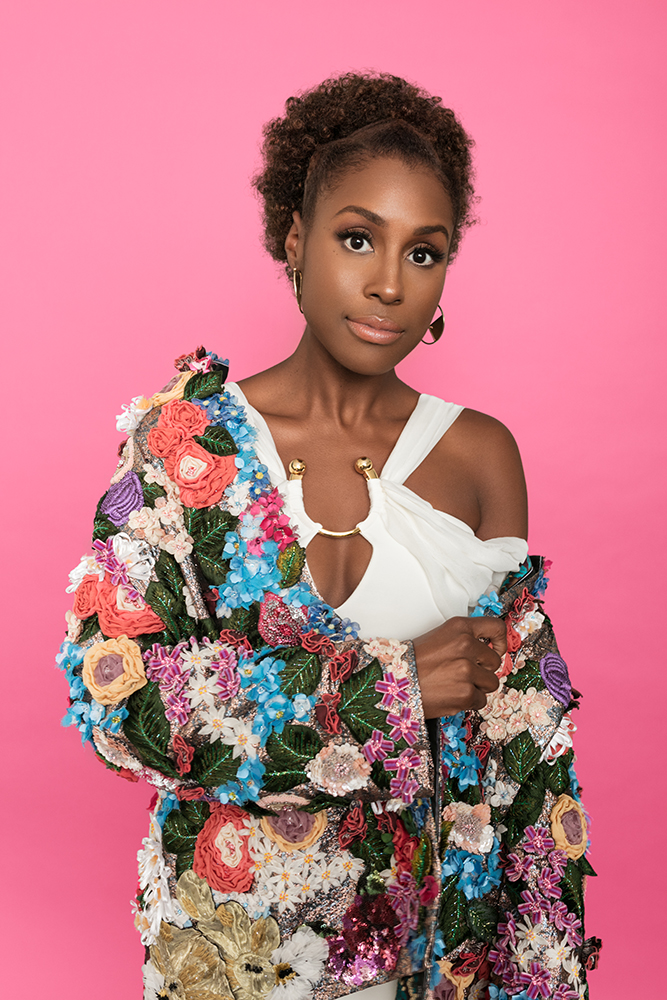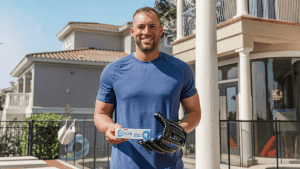Photography by Chris Loupos
Issa Rae, the Hollywood power player behind The Misadventures of Awkward Black Girl and HBO’s Insecure, didn’t see herself represented growing up and is now changing that for women and minorities.
Written by Popi Bowman
The year 2018 was a milestone year for minorities in Hollywood, with the surprising success of Black Panther – now among the top 10 highest-grossing films – and Crazy Rich Asians, which continues to break recent box-office records with domestic revenues surpassing $165 million. The 2018 Hollywood Diversity Report by UCLA, however, reveals that minorities and women “remain underrepresented on every front” – despite the fact that minorities purchased the majority of tickets for five of the top 10 films in 2016 (ranked by global box office). The report also reinforces a commonly understood fact, that people of colour and women “have faced an uphill battle” in the entertainment industry, with fewer than 13 percent of broadcast scripted shows created by women, and only 7.3 percent created by minorities – which makes Issa Rae’s success even more notable, as the first African-American woman to produce and star in a premium cable show (while still in her early 30s). This year, Rae received a Peabody award and two Emmy nominations for HBO’s Insecure, which is currently in its third season.
In addition to winning accolades from the Hollywood elite, Rae has built a massive following – including more than two million Instagram followers – by exploring the gritty realities and comedic escapades of a mostly African-American cast struggling with the everyday challenges of dating, work and, naturally, the fetters (and quirks) of race. After graduating from Stanford University in 2007 with a major in African and African-American studies and a minor in political science, Rae enrolled in the New York Film Academy. Her legacy as a producer/writer/star was cemented in 2011 when Rae launched the viral YouTube hit The Misadventures of Awkward Black Girl (also the title of her best-selling memoir, which Lena Dunham calls “brilliantly wry”). The following year, Rae landed on the Forbes “30 Under 30” list (and again in 2014); since then, she has blossomed into a CoverGirl ambassador and, literally, a cover girl for respected magazines alongside other female contemporaries, like Sarah Silverman and Saturday Night Live’s Kate McKinnon.
There’s a certain irony that Rae is affiliated with CoverGirl because she admits that in her formative years, she was chubby and rarely wore makeup. As she explains in her memoir: “Growing up, I felt like a monster in some ways. I didn’t see myself reflected at all…. And part of what inspired me, was this deep desire that before I died, I would make a couple of mirrors. That I would make some mirrors so that kids like me might see themselves reflected back and might not feel so monstrous for it.” A former “class clown” who is also a self-professed introvert, Rae grew up in contrasting neighbourhoods: a predominantly white community in Maryland, and towards the end of elementary school, her family moved to South Los Angeles – a short drive from Hollywood, but a world away. Suddenly immersed in black and Latino culture, Rae was often accused of not acting “Black enough.”
Rae admits that she felt like a fish out of water except when she spent time in Senegal, her father’s home country. “There’s nothing more confidence-building than knowing where you came from,” she explains. “My family over there is so welcoming, they’re just so proud, and there’s a set of customs that they have been abiding by for generations, so that’s amazing! I always felt like an American there, and they never let me forget that, but they’re also always just like, ‘You’re one of us.’ I think, if anything, that sense of identity helped me – but socially, I still didn’t stand a chance.” Adolescence presented the typical challenges, but as Rae remembers, “For some reason it just felt amplified because when you’re dealing with race, that’s just a whole other set of problems that white adolescents don’t have to deal with.”
Her struggle to navigate the worlds between races is part of the comedic puzzle that makes Insecure (and its inspiration, Awkward Black Girl) so relatable, but her perspective as a woman is equally amusing. Instead of taking a typically “Black comedy” approach, Rae exposes moments that viewers of any demographic can relate to – or at least, make them laugh. While Insecure continues to garner acclaim, the Awkward Black Girl episodes have logged more than 20 million views – no small feat in an increasingly crowded space.


Her eponymous production company is developing new projects for HBO, including a comedy about a bisexual Black man, called Him or Her. But perhaps Rae’s most significant project is Color Creative, a non-profit organization supporting career development for minority writers. Rather than chasing awards, Rae has her sights on helping others succeed: “Being able to give them a platform is the goal,” she admits, “in addition to venturing to other things outside of film and television, but I’m just trying to lay out, especially this year, what else I want to do.” Rae mentions her interest in environmental conservation, technology, and politics – “I’d be a terrible politician, but a lot of my friends are great, and I’m just figuring out how I can empower them to run or to be involved or to support them – I just want to be a part of something more.”
That “something more” centers around empowerment, and sharing her success in a meaningful way. “I want people to feel like, ‘Oh, if she can do it, then I can definitely do it,’” Rae explains, “and that inspires me to continue to show that there is a way, even when people tell you no – there is a way. When people tell you your content isn’t relevant, or there’s no audience, there always will be as long as you’re willing to make it happen for yourself.” Part of Rae’s process was realizing that she didn’t need to look outside of her network of friends for support – “There were definitely times when I was trying to look for people who had already ‘made it,’ who could be mentors – like, maybe Spike Lee will see my stuff and want to work with me, and that was the wrong approach. It was so necessary for me to tap into the people around me, and that really paid off.” Several of Rae’s first team members continue to work with her, and most likely she will keep building her production empire with the same core people because without them, she admits, “There’s nothing I can do without my team. If you don’t have that support, you can’t create, you won’t have the freedom to do what you want to do.” As she reflects on her current success, the one piece of advice Rae wants to share is simply: “Find your people.”
This brings us back to the topic of diversity, a subject that Rae notes has been easier to broach now that she is inside the Hollywood machine: “It feels like people are more receptive once you’re in the door – it just feels easier to get people to listen to you, and I think now it’s different with people clamouring to have representation, and so in that sense if you’re already on board with representing people, it is a lot easier – but that’s not to say it’s fixed, because they’re capitalizing on this moment for now and have no intentions on making any kind of long-standing effort to change things, so my peers and I are dedicated to that.” Among those peers, Rae mentions Ava DuVernay (the first African-American woman to win the Best Director Prize at the Sundance Film Festival, and the first to be nominated for a Golden Globe Award in 2014) and director Ryan Murphy (creator of Nip/Tuck and Glee), who founded the Half Initiative to create opportunities for women and minorities behind the camera.
The unfortunate reality is that women and minorities in Hollywood – and boardrooms – still have a long climb to reach equality, but Rae is making sure that dialogue translates into action. “These conversations have been happening for decades,” she says with a laugh. “I remember doing a diversity panel in 2011 or 2012, and my mom was like, ‘They’re still having that conversation? They were having that back in the ’70s, the ’80s, the ’90s,’ and it just always feels like it’s something that we talk about but never take action – and now it does feel like steps are being taken. Now that it’s actually affecting dollar signs, which has always been the angle, people are listening.”








